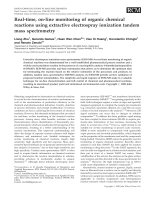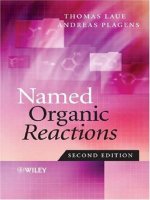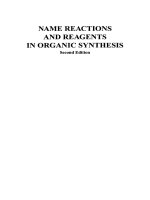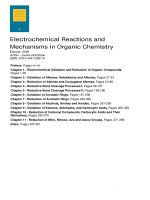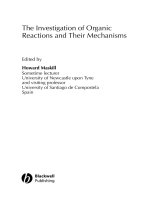Organic name reactions 2001 merck
Bạn đang xem bản rút gọn của tài liệu. Xem và tải ngay bản đầy đủ của tài liệu tại đây (3.7 MB, 446 trang )
1. Acetoacetic Ester Synthesis
Base-catalyzed alkylation or arylation of β-ketoesters. Subsequent mild hydrolysis and decarboxylation yield substituted
acetones. Alternately, treatment with concentrated base produces substituted esters:
Synthetic applications: R. Kluger, M. Brandl, J. Org. Chem. 51, 3964 (1986); T. Yamamitsu et al., J. Chem. Soc. Perkin
Trans. I 1989, 1811.
Copyright © 2001 by Merck & Co., Inc., Whitehouse Station, NJ, USA. All rights reserved.
2. Acyloin Condensation
L. Bouveault, R. Loquin, Compt. Rend. 140, 1593 (1905).
Reductive coupling of esters by sodium to yield acyloins (α-hydroxyketones). Yields are greatly improved in the presence of
trimethylchlorosilane:
K. T. Finley, Chem. Rev. 64, 573 (1964); K. Ziegler, Houben-Weyl 4/2, 729-822 (1955); S. M. McElvain, Org. React. 4, 256
(1948); J. J. Bloomfield et al., ibid. 23, 259 (1976); R. Brettle, Comp. Org. Syn. 3, 613-632 (1991). Cf. Benzoin Condensation.
Copyright © 2001 by Merck & Co., Inc., Whitehouse Station, NJ, USA. All rights reserved.
3. Akabori Amino Acid Reactions
S. Akabori, J. Chem. Soc. Japan 52, 606 (1931); Ber. 66, 143, 151 (1933); J. Chem. Soc. 64, 608 (1943).
1. Formation of aldehydes by oxidative decomposition of α-amino acids when heated with sugars according to the equation:
2. Reduction of α-amino acids and esters by sodium amalgam and ethanolic hydrogen chloride to the corresponding α-amino
aldehydes:
3. Formation of alkamines by heating mixtures of aromatic aldehydes and amino acids. No reaction was observed with tertiary
amino groups.
E. Takagi et al., J. Pharm. Soc. Japan 71, 648 (1951); 72, 812 (1952); A. Lawson, H. V. Morley, J. Chem. Soc. 1955, 1695;
A. Lawson, ibid. 1956, 307; K. Dose, Ber. 90, 1251 (1957); V. N. Belikov et al., Izv. Akad. Nauk SSSR, Ser. Khim. 1969, 2536.
Copyright © 2001 by Merck & Co., Inc., Whitehouse Station, NJ, USA. All rights reserved.
4. Aldol Reaction (Condensation)
R. Kane, Ann. Phys. Chem., Ser. 2, 44, 475 (1838); idem, J. Prakt. Chem. 15, 129 (1838).
Traditionally, it is the acid- or base-catalyzed condensation of one carbonyl compound with the enolate/enol of another, which
may or may not be the same, to generate a β-hydroxy carbonyl compound—an aldol. The method is compromised by selfcondensation, polycondensation, generation of regioisomeric enols/enolates, and dehydration of the aldol followed by Michael
addition, q.v. The development of methods for the preparation and use of preformed enolates or enol derivatives, that dictate
specific carbon-carbon bond formation, have revolutionized the coupling of carbonyl compounds:
Historical perspective: C. H. Heathcock, Comp. Org. Syn. 2, 133-179 (1991). General review: T. Mukaiyama, Org. React. 28,
203-331 (1982). Application of lithium and magnesium enolates: C. H. Heathcock, Comp. Org. Syn. 2, 181-238 (1991); of boron
enolates: B. M. Kim et al., ibid. 239-275; of transition metal enolates: I. Paterson, ibid. 301-319. Stereoselective reactions of
ester and thioester enolates: M. Braun, H. Sacha, J. Prakt. Chem. 335, 653-668 (1993). Review of asymmetric methodology: A.
S. Franklin, I. Paterson, Contemp. Org. Syn. 1, 317-338 (1994). Cf. Claisen-Schmidt Condensation; Henry Reaction; Ivanov
Reaction; Knoevenagel Condensation; Reformatsky Reaction; Robinson Annulation.
5. Algar-Flynn-Oyamada Reaction
J. Algar, J. P. Flynn, Proc. Roy. Irish Acad. 42B, 1 (1934); B. Oyamada, J. Chem. Soc. Japan 55, 1256 (1934).
Alkaline hydrogen peroxide oxidation of o-hydroxyphenyl styryl ketones (chalcones) to flavonols via the intermediate
dihydroflavonols:
T. S. Wheeler, Record Chem. Progr. 18, 133 (1957); W. P. Cullen et al., J. Chem. Soc. C 1971, 2848. Mechanism: T. R.
Gormley, et al., Tetrahedron 29, 369 (1973); M. Bennett et al., ibid. 54, 9911 (1998). Synthetic applications: H. Wagner et al.,
ibid. 33, 1405 (1977); A. C. Jain et al., Bull. Chem. Soc. Japan 56, 1267 (1983). Cf. Auwers Synthesis.
Copyright © 2001 by Merck & Co., Inc., Whitehouse Station, NJ, USA. All rights reserved.
6. Allan-Robinson Reaction
J. Allan, R. Robinson, J. Chem. Soc. 125, 2192 (1924).
Preparation of flavones or isoflavones by condensing o-hydroxyaryl ketones with anhydrides of aromatic acids and their
sodium salts:
S. F. Dyke et al., J. Org. Chem. 26, 2453 (1961); Seshandri in The Chemistry of Flavonoid Compounds, T. A. Geissman, Ed.
(New York, 1962) p 182; Gripenberg, ibid. p 411; W. Rahman, K. T. Nasim, J. Org. Chem. 27, 4215 (1962); D. L. Dreyer et al.,
Tetrahedron 20, 2977 (1964). Synthesis applications: P. K. Dutta et al., Indian J. Chem. 21B, 1037 (1982); T. Horie et al., Chem.
Pharm. Bull. 37, 1216 (1989); J. K. Makrandi et al., Synth. Commn. 19, 1919 (1989); E. J. Corey et al., Tetrahedron Letters 37,
7162 (1996); B. P. Reddy et al., J. Heterocyclic Chem. 33, 1561 (1996). Cf. Baker-Venkataraman Rearrangement; Kostanecki
Acylation.
Copyright © 2001 by Merck & Co., Inc., Whitehouse Station, NJ, USA. All rights reserved.
7. Allylic Rearrangements
L. Claisen, Ber. 45, 3157 (1912).
Migration of a carbon-carbon double bond in a three carbon (allylic) system on treatment with nucleophiles under SN1
conditions (or under SN2 conditions when the nucleophilic attack takes place at the γ-carbon):
Reviews: J. R. DeWolfe, W. G. Young, Chem. Rev. 56, 753 (1956); W. G. Young, J. Chem. Ed. 39, 455 (1962); P. de la Mare
in Molecular Rearrangements Part 1, P. de Mayo, Ed. (Wiley-Interscience, New York, 1963) pp 27-110; K. Mackenzie in The
Chemistry of Alkenes, S. Patai, Ed. (Interscience, New York, 1964) pp 436-453; R. H. DeWolfe, W. G. Young in ibid. pp 681738; J. March, Advanced Organic Chemistry (Wiley-Interscience, New York, 4th ed., 1992) pp 327-330.
Copyright © 2001 by Merck & Co., Inc., Whitehouse Station, NJ, USA. All rights reserved.
8. Amadori Rearrangement
M. Amadori, Atti Accad. Nazl. Lincei 2(6), 337 (1925), C.A. 20, 902 (1926); ibid. 9(6), 68, 226 (1929), C.A. 23, 3211, 3443
(1929).
Conversion of N-glycosides of aldoses to N-glycosides of the corresponding ketoses by acid or base catalysis:
J. E. Hodge, Advan. Carbohyd. Chem. 10, 169 (1955); R. U. Lemieux in Molecular Rearrangements Part 2, P. de Mayo, Ed.
13
(Wiley-Interscience, New York, 1964) p 753. C-NMR studies: W. Funcke, Ann. 1978, 2099. Review: K. Maruoka, H.
Yamamoto, Comp. Org. Syn. 6, 789-791 (1991).
Copyright © 2001 by Merck & Co., Inc., Whitehouse Station, NJ, USA. All rights reserved.
9. Arens-van Dorp Synthesis; Isler Modification
D. A. van Dorp, J. F. Arens, Nature 160, 189 (1947); J. F. Arens et al., Rec. Trav. Chim. 68, 604, 609 (1949); O. Isler et al.,
Helv. Chim. Acta 39, 259 (1956).
The preparation of alkoxyethynyl alcohols from ketones and ethoxyacetylene. In the Isler modification the tedious
preparation of ethoxyacetylene is obviated by treating β-chlorovinyl ether with lithium amide to yield lithium ethoxyacetylene,
which is then condensed with the ketone:
H. Heusser et al., Helv. Chim. Acta 33, 370 (1950); J. F. Arens, Advan. Org. Chem. 2, 117-212 (1960); H. Meerwein,
Houben-Weyl 6/3, 189 (1965). Cf. Favorskii-Babayan Synthesis; Nef Synthesis.
Copyright © 2001 by Merck & Co., Inc., Whitehouse Station, NJ, USA. All rights reserved.
10. Arndt-Eistert Synthesis
F. Arndt, B. Eistert, Ber. 68, 200 (1935).
Homologation of carboxylic acids:
Alternative reagent for diazomethane: T. Aoyama, Tetrahedron Letters 21, 4461 (1980). Application to synthesis of
unsaturated diazoketones: T. Hudlicky et al., ibid. 1979, 2667; K. Gademann et al., Angew. Chem. Int. Ed. 38, 1223 (1999); via
ultrasonic activation: J-Y. Winum et al., Tetrahedron Letters 37, 1781 (1996); of amino acids: R. E. Marti et al., ibid. 38, 6145
(1997); R. J. DeVita et al., Bioorg. Med. Chem. Letters 9, 2621 (1999). Reviews: W. E. Bachmann, W. S. Struve, Org. React. 1,
38-62 (1942); B. Eistert in Newer Methods in Preparative Organic Chemistry vol. 1 (Interscience, New York, 1948) pp 513570; G. B. Gill, Comp. Org. Syn. 3, 888-889 (1991). Cf. Wolff Rearrangement.
Copyright © 2001 by Merck & Co., Inc., Whitehouse Station, NJ, USA. All rights reserved.
11. Auwers Synthesis
K. v. Auwers et al., Ber. 41, 4233 (1908); 48, 85 (1915); 49, 809 (1916); K. v. Auwers, P. Pohl, Ann. 405, 243 (1914).
Expansion of coumarones to flavonols by treatment of 2-bromo-2-(α-bromobenzyl)coumarones with alcoholic alkali:
T. H. Minton, H. Stephen, J. Chem. Soc. 121, 1598 (1922); J. Kalff, R. Robinson, ibid. 127, 1968 (1925); B. H. Ingham et
al., ibid. 1931, 895; B. G. Acharya et al., ibid. 1940, 817; S. Wawzonek, Heterocyclic Compounds 2, 245 (1951). Cf. AlgarFlynn-Oyamada Reaction.
Copyright © 2001 by Merck & Co., Inc., Whitehouse Station, NJ, USA. All rights reserved.
12. Baeyer-Drewson Indigo Synthesis
A. Baeyer, V. Drewson, Ber. 15, 2856 (1882).
Formation of indigos by an aldol reaction, q.v., of o-nitrobenzaldehydes to acetone, pyruvic acid or acetaldehyde; of interest
mainly as a method of protecting o-nitrobenzaldehydes:
K. Venkataraman, Chemistry of Synthetic Dyes 2, 1008 (New York, 1952); M. Sainsbury, Rodd's Chemistry of Carbon
Compounds IVB, 346, 353 (1977). Synthetic applications: J. R. Mckee et al., J. Chem. Ed. 68, A242 (1991); L. Fitjer et al.,
Tetrahedron 55, 14421 (1999).
Copyright © 2001 by Merck & Co., Inc., Whitehouse Station, NJ, USA. All rights reserved.
13. Baeyer-Villiger Reaction
A. Baeyer, V. Villiger, Ber. 32, 3625 (1899); 33, 858 (1900).
The oxidation of ketones to esters or lactones by peracids:
Reviews: P. A. S. Smith in Molecular Rearrangements Part 1, P. de Mayo, Ed. (Wiley-Interscience, New York, 1963) pp
577-591; J. B. Lee, B. C. Uff, Quart. Rev. Chem. Soc. 21, 429-457 (1967); C. H. Hassall, Org. React. 9, 73 (1957); G. R. Krow,
ibid. 43, 251-798 (1993); idem, Comp. Org. Syn. 7, 671-688 (1991).
Copyright © 2001 by Merck & Co., Inc., Whitehouse Station, NJ, USA. All rights reserved.
14. Baker-Venkataraman Rearrangement
W. Baker, J. Chem. Soc. 1933, 1381; H. S. Mahal, K. Venkataraman, ibid. 1934, 1767.
Base-catalyzed rearrangement of o-acyloxyketones to β-diketones, important intermediates in the synthesis of chromones
and flavones:
Gripenberg in The Chemistry of Flavonoid Compounds, Geissman, Ed. (New York, 1962) p 410. Mechanistic studies: K.
Bowden, M. Chehel-Amiran, J. Chem. Soc. Perkin Trans. II 1986, 2039. Synthetic applications: P. K. Jain et al., Synthesis
1982, 221; J. Zhu et al., Chem. Commun. 1988, 1549; A. V. Kalinin et al., Tetrahedron Letters 39, 4995 (1998); D. C. G. Pinto
et al., New J. Chem. 24, 85 (2000). Cf. Allan-Robinson Reaction; Kostanecki Acylation.
Copyright © 2001 by Merck & Co., Inc., Whitehouse Station, NJ, USA. All rights reserved.
15. Bamberger Rearrangement
E. Bamberger, Ber. 27, 1347, 1548 (1894).
Intermolecular rearrangement of N-phenylhydroxylamines in aqueous acid to give the corresponding 4-aminophenols:
Early review: H. J. Shine, Aromatic Rearrangements (Elsevier, New York, 1967) pp 182-190. Kinetic and mechanistic
study: G. Kohnstam et al., J. Chem. Soc. Perkin Trans. II 1984, 423. Synthetic application: D. Johnston, D. Elder, J. Labelled
Compd. Radiopharm. 25, 1315 (1988). Modified conditions: A. Zoran et al., Chem. Commun. 1994, 2239; M. Tordeux, C.
Wakselman, J. Fluorine Chem. 74, 251 (1995).
Copyright © 2001 by Merck & Co., Inc., Whitehouse Station, NJ, USA. All rights reserved.
16. Bamford-Stevens Reaction; Shapiro Reaction
W. R. Bamford, T. S. Stevens, J. Chem. Soc. 1952, 4735.
Formation of olefins by base-promoted decomposition of p-toluenesulfonylhydrazones of aldehydes and ketones:
The formation of unrearranged alkenes, generally the less substituted isomers, by treatment of ketone derived ptoluenesulfonylhydrazones with alkyl lithium reagents is known as the Shapiro reaction: R. H. Shapiro, M. J. Heath, J. Am.
Chem. Soc. 89, 5734 (1967). Use of N,N-diethylaminosulfonylhydrazones: J. Kang et al., Bull. Korean Chem. 13, 192 (1992).
Silicon directing effect: T. K. Sarkar, B. K. Ghorai, Chem. Commun. 1992, 1184. Reviews: R. H. Shapiro, Org. React. 23,
405-507 (1976); R. M. Adlington, A. G. M. Barrett, Accts. Chem. Res. 16, 55-59 (1983); K. Maruka, H. Yamamoto, Comp.
Org. Syn. 6, 776-779 (1991); A. R. Chamberlin, D. J. Sall, ibid. 8, 944-949.
Copyright © 2001 by Merck & Co., Inc., Whitehouse Station, NJ, USA. All rights reserved.
17. Barbier(-type) Reaction
P. Barbier, C. R. Acad. Sci. 128, 110 (1899).
One-step procedure for the preparation of alcohols from organic halides and aldehydes or ketones:
Review of mechanistic studies of Sm-mediated coupling: D. P. Curran et al., Synlett 1992, 943-961. Book: C. Blomberg,
The Barbier Reaction and Related One-Step Processes, K. Hafner et al., Eds. (Springer-Verlag, New York, 1993) 183 pp. Znpromoted coupling: F. Hong et al., Chem. Commun. 1994, 289. Sm-mediated coupling: M. Kunishima et al., Chem. Pharm.
Bull. 42, 2190 (1994). Comparison with Ni(0) insertion chemistry for intramolecular cyclization: M. Kihara et al., Tetrahedron
48, 67 (1992). Cf. Grignard Reaction.
Copyright © 2001 by Merck & Co., Inc., Whitehouse Station, NJ, USA. All rights reserved.
18. Barbier-Wieland Degradation
H. Wieland, Ber. 45, 484 (1912); P. Barbier, R. Locquin, Compt. Rend. 156, 1443 (1913).
Stepwise carboxylic acid degradation of aliphatic acids (particularly in sterol side chains) to the next lower homolog. The
ester is converted to a tertiary alcohol that is dehydrated with acetic anhydride, and the olefin oxidized with chromic acid to a
lower homologous carboxylic acid:
H. Wieland et al., Z. Physiol. Chem. 161, 80 (1926); C. W. Shoppee, Ann. Repts. (Chem. Soc., London) 44, 184 (1947); W.
Baker et al., J. Chem. Soc. 1958, 1007; J. R. Dias, R. Ramachandra, Tetrahedron Letters 1976, 3685. Synthetic applications: S.
C. Wilcox, J. J. Guadino, J. Am. Chem. Soc. 108, 3102 (1986); C. D. Schteingart, A. E. Hofmann, J. Lipid Res. 29, 1387
(1988). Cf. Krafft Degradation; Miescher Degradation.
Copyright © 2001 by Merck & Co., Inc., Whitehouse Station, NJ, USA. All rights reserved.
19. Bart Reaction; Scheller Modification
H. Bart, DE 250264 (1910); DE 254092 (1910); DE 264924 (1910); DE 268172 (1912); Ann. 429, 55 (1922); E. Scheller, GB
261026; A. W. Ruddy et al., J. Am. Chem. Soc. 64, 828 (1942).
Formation of aromatic arsonic acids by treating aromatic diazonium compounds with alkali arsenites in the presence of
cupric salts or powdered silver or copper; in the Scheller modification primary aromatic amines are diazotized in the presence
of arsenious chloride and a trace of cuprous chloride:
The modified Bart reaction can be applied to the formation of arylstibonic acids:
C. F. Hamilton, J. F. Morgan, Org. React. 2, 415 (1944); G. O. Doak, H. G. Steinman, J. Am. Chem. Soc. 68, 1987 (1946);
K. H. Saunders, Aromatic Diazo-Compounds and Their Technical Applications (London, 1949) p 330; W. A. Cowdry, D. S.
Davies, Quart. Rev. 6, 363 (1952).
Copyright © 2001 by Merck & Co., Inc., Whitehouse Station, NJ, USA. All rights reserved.
20. Barton Decarboxylation
D. H. R. Barton et al., Chem. Commun. 1983, 939; eidem, Tetrahedron 41, 3901 (1985).
Radical decarboxylation of organic acids to the corresponding noralkane with tri-n-butyltin hydride or t-butylmercaptan:
Synthetic application: F. E. Ziegler, M. Belema, J. Org. Chem. 62, 1083 (1997).
Copyright © 2001 by Merck & Co., Inc., Whitehouse Station, NJ, USA. All rights reserved.
21. Barton Deoxygenation (Barton-McCombie Reaction)
D. H. R. Barton, S. W. McCombie, Perkin Trans. I 1975, 1574.
Deoxygenation of alcohols via their thiocarbonyl derivatives which undergo free radical scission upon treatment with tri-nbutyltin hydride:
Mechanistic study: J. E. Forbes, S. Z. Zard, Tetrahedron Letters 30, 4367 (1989). Review: M. Pereyre et al., Tin in Organic
Synthesis (Butterworths, Boston, 1987) pp 84-96. Review of methodological improvements, particularly the replacement of trin-butyltin hydride with silicon hydrides: C. Chatgilialoglu, C. Ferreri, Res. Chem. Intermed. 19, 755-775 (1993).
Copyright © 2001 by Merck & Co., Inc., Whitehouse Station, NJ, USA. All rights reserved.
22. Barton Olefin Synthesis (Barton-Kellogg Reaction)
D. H. R. Barton et al., Chem. Commun. 1970, 1226; R. M. Kellogg, S. Wassenaar, Tetrahedron Letters 1970, 1987; R. M.
Kellogg et al., ibid. 4689.
3
Olefin synthesis by two-fold extrusion of nitrogen and sulfur from a ∆ -1,3,4-thiadiazoline intermediate. Particularly
applicable to the synthesis of moderately hindered tetra-substituted ethylenes:
Scope and limitations: D. H. R. Barton et al., J. Chem. Soc. Perkin Trans. I 1974, 1794. Synthetic applications: A. P.
Schaap, G. R. Faler, J. Org. Chem. 38, 3061 (1973); L. K. Bee et al., ibid. 40, 2212 (1975); M. D. Bachi et al., Tetrahedron
Letters 1978, 4167; J. E. McMurry et al., J. Am. Chem. Soc. 106, 5018 (1984); F. J. Hoogesteger et al., J. Org. Chem. 60, 4375
(1995). Cf. McMurry Reaction.
Copyright © 2001 by Merck & Co., Inc., Whitehouse Station, NJ, USA. All rights reserved.
23. Barton Reaction
D. H. R. Barton et al., J. Am. Chem. Soc. 82, 2640 (1960); 83, 4076 (1961).
Conversion of a nitrite ester to a γ-oximino alcohol by photolysis involving the homolytic cleavage of a nitrogen-oxygen
bond followed by hydrogen abstraction:
M. Akhtar, Advan. Photochem. 2, 263 (1964); R. H. Hesse, Advan. Free Radical Chem. 3, 83 (1969); J. Kalvoda, Angew.
Chem. Int. Ed. 8, 525 (1964). Mechanism: D. H. R. Barton et al., J. Chem. Soc. Perkin Trans. I 1979, 1159. Synthetic
application: A. Herzog et al., Angew. Chem. Int. Ed. 37, 1552 (1998).
Copyright © 2001 by Merck & Co., Inc., Whitehouse Station, NJ, USA. All rights reserved.
24. Barton-Zard Reaction
D. H. R. Barton et al., Tetrahedron 46, 7587 (1990).
Formation of a pyrrole by condensation of a substituted nitroso-alkene with an isocyanoester:
Synthetic applications: T. D. Lash et al., Tetrahedron Letters 35, 2493 (1994); idem. et al., ibid. 38, 2031 (1997); E. T.
Pelkey et al., Chem. Commun. 1996, 1909.
Copyright © 2001 by Merck & Co., Inc., Whitehouse Station, NJ, USA. All rights reserved.
25. Baudisch Reaction
O. Baudisch et al., Naturwiss. 27, 768, 769 (1939); Science 92, 336 (1940); J. Am. Chem. Soc. 63, 622 (1941).
Synthesis of o-nitrosophenols from benzene or substituted benzenes, hydroxylamine and hydrogen peroxide in the presence
of copper salts:
K. Maruyama et al., Tetrahedron Letters 1966, 5889; J. Org. Chem. 32, 2516 (1967); Bull. Chem. Soc. Japan 44, 3120
(1971); W. Seidenfaden, Houben-Weyl 10/1, 1025, 1027 (1971).
Copyright © 2001 by Merck & Co., Inc., Whitehouse Station, NJ, USA. All rights reserved.
